How to Grow Chayote, it also known as mirliton or vegetable pear. This vigorous vine produces delicious, versatile fruits and edible greens. Our comprehensive guide walks you through everything from sprouting the unique seed-fruit to harvesting your abundant crop, with tips tailored for success in various climates.
What is Chayote Squash (Mirliton)?
Chayote (Sechium edule) is a member of the gourd family, related to cucumbers and melons. Native to Mesoamerica, it’s a perennial vine in warmer climates (USDA Zones 8+) but often grown as an annual where frost occurs. The entire pale green, pear-shaped fruit contains a single large, soft seed and is planted whole. It has a mild, slightly sweet flavor and crisp texture, absorbing flavors well in cooking.
Getting Started: Sprouting Your Chayote Fruit
Unlike typical garden vegetables, you don’t remove the seed from chayote. You’ll sprout the entire fruit to start your plant.
Selecting the Right Fruit
Choose a mature, firm chayote fruit from a grocery store or farmers market. Look for one without bruises, soft spots, or significant damage. Fruits that already show a small sprout emerging from the broad end are perfect, but unsprouted ones work fine too.
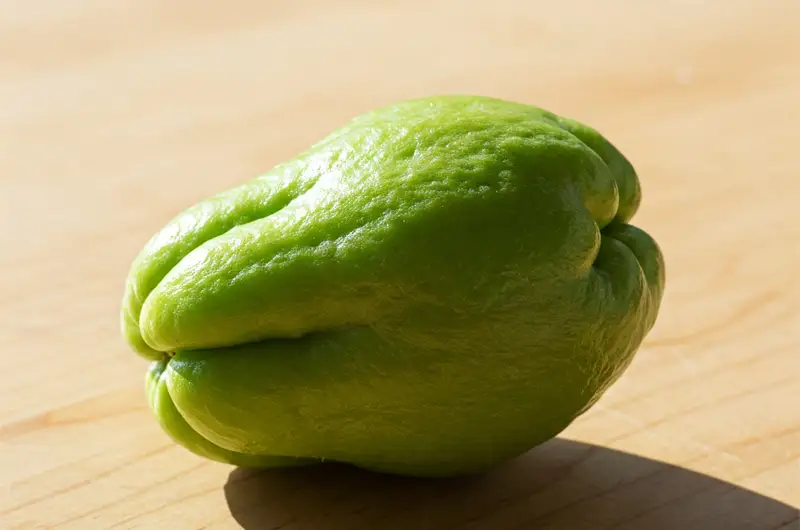
How to Sprout Chayote
There are a few easy methods to encourage sprouting:
- Cool & Dark: Place the fruit in a paper bag or loosely wrap it in cloth. Store in a cool, dark place like a pantry for several weeks.
- Water Method: Stand the fruit, broad end down, in a jar with about an inch of water, keeping most of the fruit dry. Place in indirect light and change water every few days.
- Pot Method: Plant the fruit directly following the planting instructions below, but keep the pot indoors or in a sheltered warm spot until ready to plant out.
Wait until a vine sprout is visible (a few inches long) and roots begin to form before planting outdoors.
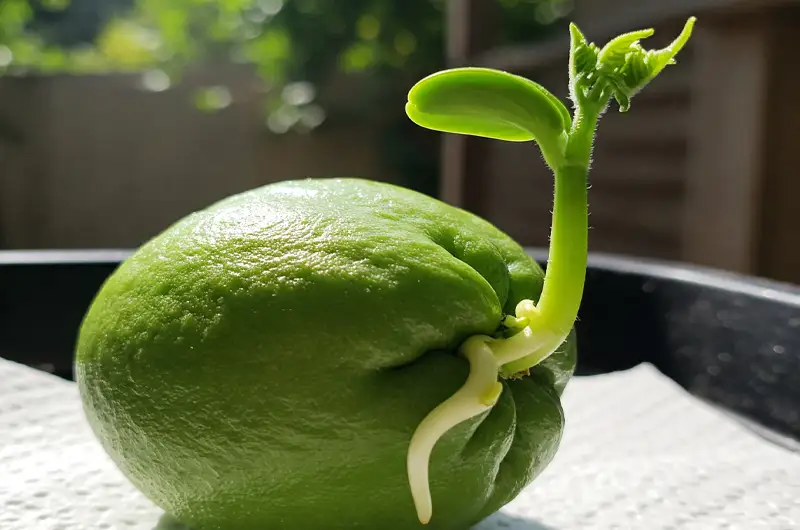
Planting Chayote Squash: Step-by-Step
Proper planting sets the stage for a healthy, productive vine.
When to Plant Chayote
In warm climates, you can plant chayote year-round, though the start of the rainy season is often ideal. In areas with frost, plant outdoors only after all danger of frost has passed and the soil has warmed up. Chayote is very sensitive to cold.
Choosing the Best Planting Site
- Sunlight: Full sun (6-8+ hours daily) is essential for maximum fruit production.
- Space: This vine is a vigorous grower! Give it plenty of room – vines can easily reach 20-30 feet (6-9 meters).
- Support: Provide a very strong trellis, arbor, fence, or pergola at planting time. The vine needs something sturdy to climb and support the weight of foliage and dozens of fruits.
Preparing the Soil for Chayote
Chayote thrives in rich, well-draining soil. Amend your planting area generously with compost or well-rotted manure. If you have heavy clay, improve drainage by adding organic matter or planting in a raised bed or mound. Aim for a soil pH between 6.0 and 6.8.
How to Plant the Sprouted Fruit
- Dig a hole wider than the fruit and incorporate compost.
- Place the entire sprouted fruit in the hole at roughly a 45-degree angle, sprout-end pointing slightly downward.
- Position the fruit so the top (narrow end) is level with or just slightly below the soil surface. Some growers leave the very tip exposed. Do not bury it deep.
- Gently backfill with soil and firm it around the fruit.
- Water thoroughly.
- Space multiple plants at least 8-10 feet (2.5-3 meters) apart.
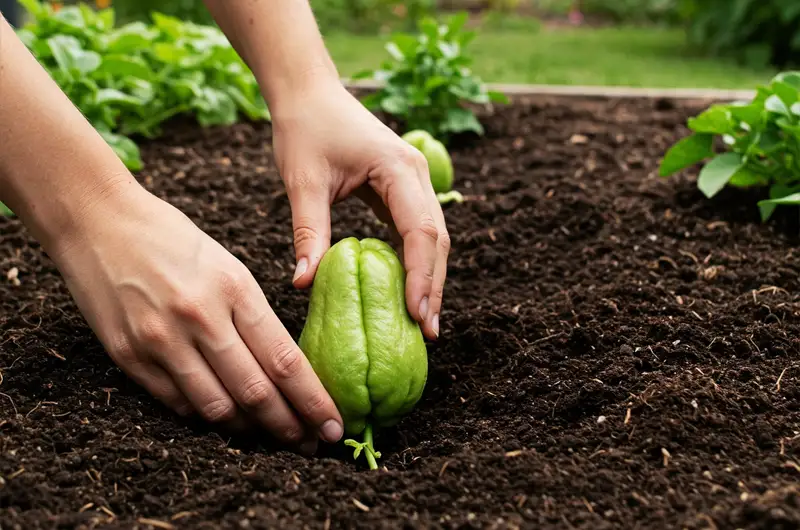
Caring for Your Chayote Plant
Consistent care helps ensure a vigorous vine and a bountiful harvest.
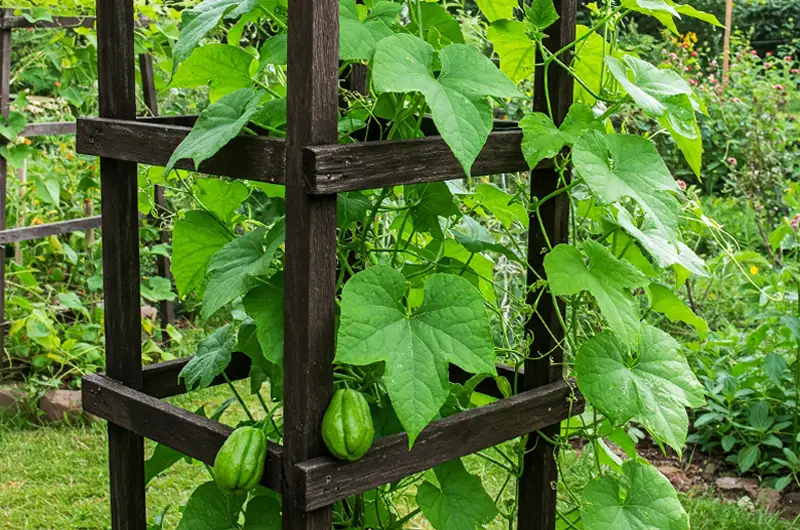
Watering Needs for Chayote
Keep the soil consistently moist, especially during hot weather and when the plant is flowering and setting fruit. Water deeply at the base, adjusting for rainfall. Avoid soggy soil.
Providing Strong Support (Trellising)
As the vine grows, gently guide its tendrils towards the support structure. It will quickly latch on and climb aggressively. Ensure your trellis is tall (6+ feet / 2+ meters) and sturdy enough for the eventual weight.
Fertilizing Your Growing Chayote
Chayote is a heavy feeder.
- Start with rich, amended soil.
- Side-dress with compost or aged manure every 4-6 weeks during the growing season.
- Alternatively, use a balanced organic fertilizer according to package directions. Avoid excessive nitrogen, which favors leaves over fruit.
Mulching Benefits
Apply a 2-3 inch layer of organic mulch (straw, shredded leaves, rice hulls) around the base (but not touching the stem). Mulch conserves moisture, suppresses weeds, and regulates soil temperature.
Harvesting Chayote Squash
Enjoying the fruits (and greens!) of your labor is easy.
When is Chayote Ready to Pick?
Harvest fruits when they are young and tender, typically 4-6 inches (10-15 cm) long. The skin should be smooth and easily pierced with a fingernail. Don’t wait too long, as they become tough. Expect your first harvest around 120-150 days from planting the sprout.
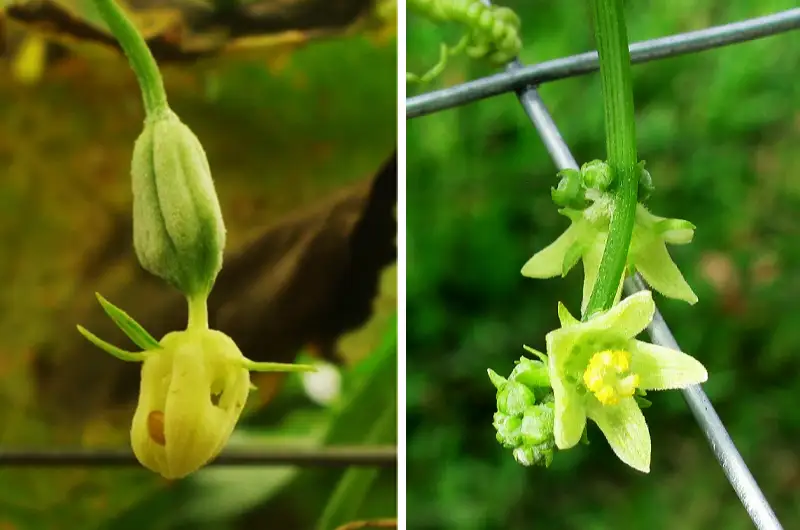
How to Harvest Chayote Fruit and Greens
- Use pruning shears or a knife to cut the fruit from the vine, leaving a small piece of stem attached.
- Check vines frequently during peak season, as fruits develop quickly.
- Young leaves and the tender tips of the vines (shoots) are also edible. Harvest sparingly and cook them like other greens in stir-fries and soups (canh).
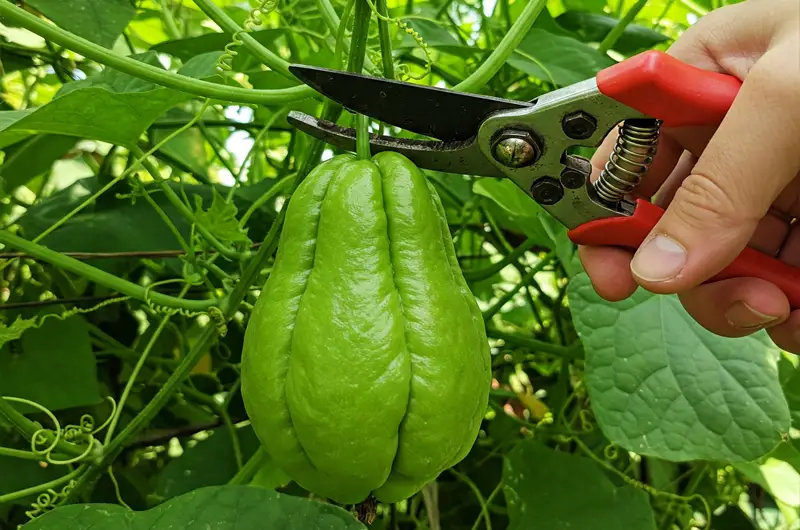
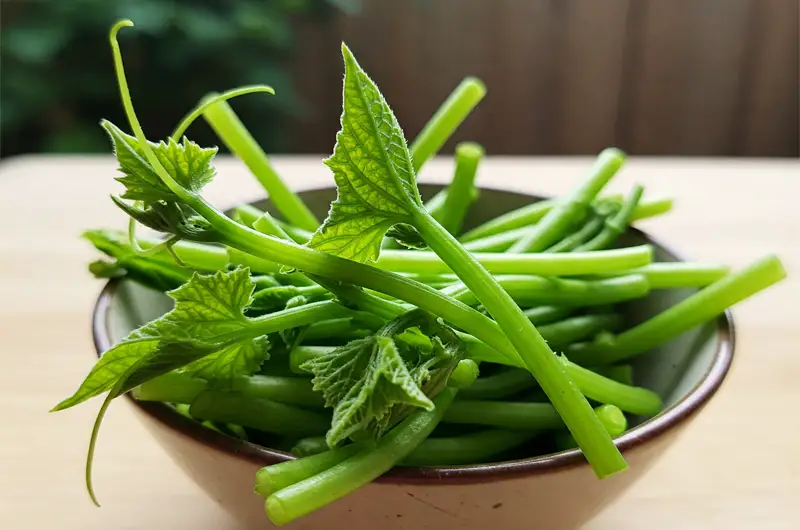
Managing Pests and Diseases
While relatively robust, chayote can face issues like aphids, squash bugs, and powdery mildew (especially in humid conditions). Encourage good air circulation via trellising, water at the base, and use organic controls like insecticidal soap or neem oil as needed. Remove heavily infested leaves promptly.
Overwintering Chayote in Different Climates
How you handle chayote over winter depends on your climate zone.
Chayote as a Perennial (Warm Zones)
In warm, frost-free climates, chayote acts as a perennial. The roots survive year-round, and the vine resprouts or continues growing. You can prune it back after harvest or if it becomes too unruly to manage size and encourage fresh, productive growth.
Protecting Chayote in Cooler Zones
In zones 7 and colder (experiencing frost/freezing), chayote is typically grown as an annual. Gardeners there may try digging up and storing the roots or heavily mulching to attempt overwintering.
Quick Tips for Success When You Grow Chayote Squash
- Start with a Healthy Fruit: Choose a firm, unblemished one.
- Provide Sturdy Support: Essential for managing the vigorous vine.
- Ensure Full Sun: Maximizes fruit production.
- Use Rich, Well-Drained Soil: Amend generously with compost.
- Water Consistently: Especially during fruit development and dry periods.
- Harvest Young & Often: For the best flavor and texture, and to encourage more fruit.
- Don’t Forget the Greens: Young shoots and leaves are delicious too!
Read More about Chayote: Chayote Dishes: Ideas & Popular Dishes with Chayote
Latest Posts:


